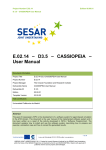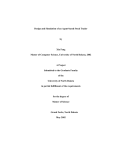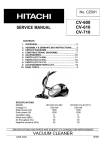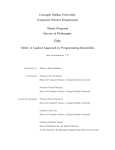Download DeCoLibrary User Guide
Transcript
DeCoAgent
Deliberative Coherence Driven Agent
User Guide
DeCoAgentLibrary v1.0
30 June 2014
This document presents a user manual for DeCoAgent Library package. Any person who
want to create a DeCoAgent can use this tutorial. In the first part of the user manual environment
configuration of the DeCoAgent Library will be presented. In the second part, a Cleaner World
agent, a famous example in intelligent agent literature, design and implementation with the usage
of DeCoAgent Library will be presented.
A.1
Development and Execution Environment Configuration
1. Prerequisites
Download and install a recent Java environment from http://java.sun.com/javase/downloads (if
not installed).
Download and install a suitable Eclipse distribution (>=3.5) from
http://www.eclipse.org/downloads (if not installed).
Download Jadex 2.3 distribution .zip from http://jadex-agents.informatik.unihamburg.de/xwiki/bin/view/Download/Available+Packages and unpack it to a place of your
choice.
Download DeCoAgent package (DeCoAgentLib.jar) from
https://sourceforge.net/projects/decoagentlibrary
2. Eclipse Environment Setup
Start Eclipse IDE and start the ‘New Java Project’ wizard, disable the ‘Use default location’
checkbox and browse to the directory, where you unpacked the Jadex distribution.
Figure 1 Creation of Java Project in Eclipse
Click ‘Finish’ – then the project will be created. Your project should now appear IN your
package explorer. This project will be used as a basis for your own development projects. To make
the Jadex libraries accessible to other projects it is necessary in Eclipse to export them. Right-click
on project, choose ‘Build Path -> Configure Build Path...’. Go to the ‘Order and Export’ tab, choose
‘Select All’ and hit ‘Ok’.
Figure 2 Export .jars from Build Path
To start the Jadex platform right-click on the Jadex project, which is in the package explorer.
Then choose ‘Run As’ > ‘Java Application’ from the pop-up menu. Eclipse will search for main
types (startable main classes). Select Starter from the package jadex.base in the dialog.
Figure 3 Select Starter Class for Starting Jadex Platform
Hit ‘Ok’ to start the Jadex platform. The next time you want to start the platform, you do
not have to repeat the above steps. Just choose the ‘Starter’ entry from the run history, which eclipse
generates automatically.
If you successfully start the Jadex platform, the Jadex control center (JCC) will appear in the
screen as seen in Fig. 4. The JCC is a management and debugging interface for the Jadex platform
and components that run on it. To execute any application you need to add the corresponding path
to the JCC project. We will now set up the platform for starting some examples. Right-click in the
upper left area (called the model explorer, as it is used to browse for models of e.g. processes) and
choose ‘Add Path’.
Figure 4 Add Path in JCC
For executing a sample agent open the lib directory and select the file jadex-applicationsmicro-.....jar. You can now unfold the contents of the jar file and browse to the helloworld example
in the jadex/examples package. After you select the HelloWorldAgent.class in the tree, you can start
the process by clicking 'Start'. The component will be executed and it will print some messages to
the (eclipse) console.
3. Create and Setup a DeCo Agent Project
Create a new Java project from ‘File’ -> ’New’ -> ’New Java Project’ and name it as
DeCoExamples. Choose your project location or use default one. Click ‘Finish’ – then your empty
java project will be created and shown in package explorer.
Figure 5 Create DeCoExamples Java Project
DeCo Agent library needs Jadex libraries for execution. Put DeCoAgentLib.jar file under the
Jadex project source library file. For configuring our DeCoExamples project, right-click on project
and choose ‘Build Path -> Configure Build Path...’. Go to the ‘Libraries’ tab, choose ‘Add JARs...’
and choose Jadex project from appearing window and add all library files to the project. Then
choose ‘Add External JARs...’, browse the DeCoAgent.lib file that needs to be added the Jadex lib
source and choose ‘OK’. After importing the necessary libraries go to the ‘Order and Export’ tab
and change the order of the DeCoAgentLib.jar for it to be above Jadex libraries as shown in Fig.
6.
Figure 6 Change the Order of the DeCoAgentLib
The configuration of our environment is completed. Now we can start to implement our first
DeCoAgent.
A.2
Implementing a DeCoAgent
1. First DeCo Agent
Choose DeCoExamples project from package explorer and create a new package called
‘deco.jadex.examples’. DeCoAgent is a BDIv3 agent and most of its properties belong to Jadex
BDIAgent. For BDIAgent detailed documentation, you can visit Jadex Active Components site
(http://www.activecomponents.org/bin/view/BDI+V3+Tutorial/01+Introduction). The agent definition file is a normal
Java class that uses @Agent annotation to state that is an agent. It is required that the Java file ends
with “DeCo”. Otherwise it will not be recognized as DeCoAgent.
Create a new empty Java class and name it as HelloDeCo.class. Add @Agent annotation
before HelloDeCo class definition. This annotation states that this class is an agent. Add a variable
called ‘agent’ to the agent class and add annotation @Agent above the agent variable. The field
should be type of DeCoAgent. This will let the engine automatically inject the DeCo Agent (API)
to the plain old java object (pojo) agent class. Add an agent body method that is automatically
invoked when the agent is started. Add a println line inside the agent body for console output.
package deco.jadex.examples;
import deco.jadex.bdiv3.DeCoAgent;
import jadex.micro.annotation.Agent;
import jadex.micro.annotation.AgentBody;
@Agent
public class HelloDeCo
{
@Agent
DeCoAgent agent;
@AgentBody
public void body()
{
System.out.println("Hello World!");
}
}
Figure 7 First DeCoAgent Example
This first agent is not different from a classic BDIAgent and does not contain any DeCoAgent
ability. We implement this agent for testing our environment.
2. Executing DeCoAgent
Jadex Control Center only executes its inner assigned agent types (MicroAgent,
BDIAgent…). DeCoAgent is an extension package for Jadex platform and cannot be executed
within JCC. But, Jadex is a service based library and we can use its services with Jadex libraries.
We will execute our agents with a Java application that contains main function.
Create a new java class file named ExecuteMain.class. Add a main method to the class. As
explained above, place the following code inside the method body.
This code first defines a string array with default settings as shown below:
-gui false disables the JCC
-welcome false disables printing of the welcome message with the platform setup
-cli false disables the command line interface
-printpass false disables printing of platform password
After that a new array is created. First one is filled with the default arguments and then second
one is filled with the args which are supplied to the main method. Therefore, in case of conflicts
the arguments supplied from the outside override the default settings. Make sure that in
the createPlatform(...) method the newargs array is passed instead of the args. Otherwise the
default settings will be ignored.
package deco.jadex.examples;
import
import
import
import
import
import
import
jadex.base.Starter;
jadex.bridge.IExternalAccess;
jadex.bridge.service.RequiredServiceInfo;
jadex.bridge.service.search.SServiceProvider;
jadex.bridge.service.types.cms.IComponentManagementService;
jadex.commons.future.IFuture;
jadex.commons.future.ThreadSuspendable;
public class ExecuteMain{
public static void main(String[] args)
{
String[] defargs = new String[]
{
"-gui", "false",
"-welcome", "false",
"-cli", "false",
"-printpass", "false"
};
String[] newargs = new String[defargs.length+args.length];
System.arraycopy(defargs, 0, newargs, 0, defargs.length);
System.arraycopy(args, 0, newargs, defargs.length,
args.length);
IFuture<IExternalAccess>
platfut =
Starter.createPlatform(newargs);
ThreadSuspendable sus = new ThreadSuspendable();
IExternalAccess platform = platfut.get(sus);
System.out.println("Started platform:
"+platform.getComponentIdentifier());
IComponentManagementService cms =
SServiceProvider.getService(platform.getServiceProvider(),
IComponentManagementService.class,
RequiredServiceInfo.SCOPE_PLATFORM).get(sus);
cms.createComponent("deco.jadex.examples.HelloDeCo.class",null)
.get(sus);
}
Figure 8 Main Class for DeCoAgent Execution
In order to search component management service and to create an access point for the service
mechanism we use the static helper class SServiceProvider from package jadex.bridge.service.search.
The result of the getService(...) method is a future of the corresponding service type. The
application is still running on the Java main thread, therefore it is safe to use the thread suspendable again
for blocking until the search result is available.
We pass our DeCoAgent class name with package to the createComponent(...) function of
the component management service.
Finally we run ExecuteMain.class as a java application and our HelloDeCo agent is started
to run on platform Jadex. The execution’s output of the agent will be shown in Eclipse console
panel as “Hello World!”.
3. DeCoAgent Design and Implementation
DeCoAgent implementation needs a deliberative coherence model. Before implementing our
DeCoAgent, we will describe the scenario of the cleaner world. After the definition of goals and
actions, we will design our deliberative coherence model and finally we will implement our
DeCoAgent. In this document we will explain DeCoAgent capabilities within four exercises in
expanding manner. In each step we will add additional abilities to our agent.
a. Cleaner World General Scenario Description
A cleaner is an autonomous robot that can randomly move around, can sense the dirtiness,
can clean the dirtiness, and can recharge itself. The cleaner agent description according to PEAS
criteria presented in Table 17. The environment of the agent will be a room that have no object.
Table 1 PEAS Description of Cleaner World
Performance
Clean
Cleaner tries to keep its environment clean.
Keep Battery Loaded
When battery level below than a defined
value, it should return charging station to
keep battery loaded.
Partially observable
Cleaner can only sense current position of the
environment, where it possess.
Static
Environment is not changing in Cleaner
reasoning process.
Stochastic
The next state of the environment cannot be
determined with current state.
Continues
Steering is a continues-state and continuestime problem.
Steering
For moving around.
Vacuum
For cleaning the dirtiness.
Dirtiness Sensor
For sensing the dirtiness.
Environment
Actuators
Sensors
b. Case Study-1
(1) Scenario Description
According to the first case study, cleaner will have no performance criteria, a steering actuator
and no sensor. It will only move around randomly.
(2) DeCoModel Design
Firstly we will create an agent that is only moving around. Our goal will be MoveAround
and our action will be Move. MoveAround will only create a random position and post it to Move
action. Our deliberative coherence model will be as in Fig. 9. When MoveAround goal priority is
1 both of the units will be activated (left side model) and when MoveAround goal priority is 0 both
of the units will be deactivated (right side model).
Figure 9 Exercise 1 Cleaner DeCo Model
According to our created model when MoveAround priority is 1 MoveAround goal activation
will be 0.54 and Move action activation will be 0.29. When MoveAround priority is 0 MoveAround
goal activation will be 0.54 and Move action activation will be 0.29.
(3) Implementation
Create a new package and name it as “deco.jadex.examples.cleaner”. Right click on the
package, create new java class file and name it as “CleanerDeCo.java”. Add @Agent annotation
before the class definition. Add DeCoAgent API as an attribute for the agent. Our agent currently
will only move around. We need two beliefs for keeping agent coordinates (xPos - yPos). We add
our beliefs to agent by @Belief annotation. We generate getter and setter functions of these beliefs
from menu ‘Source -> Generate Getters and Setters’.
Imported DeCoAgent libraries are sensitive and may be interfered with Jadex BDIv3
libraries. Keep in mind that when you are implementing a DeCoAgent, you should not import any
BDIv3 library.
package deco.jadex.examples.cleaner;
import deco.jadex.bdiv3.DeCoAgent;
import deco.jadex.bdiv3.annotation.Belief;
import jadex.micro.annotation.Agent;
@Agent
public class CleanerDeCo
{
@Agent
DeCoAgent agent;
@Belief
private double xPos;
@Belief
private double yPos;
public double getxPos()
{
return xPos;
}
public void setxPos(double xPos)
{
this.xPos = xPos;
}
public double getyPos()
{
return yPos;
}
public void setyPos(double yPos)
{
this.yPos = yPos;
}
}
Figure 10 CleanerDeCo Agent Definition
For now our agent have no goals. We will add our first goal Move to our agent. As we
mentioned earlier, DeCoAgent has all of the Jadex BDIv3 abilities. You can define goals with Inner
Classes or Classes. We will define our goals with inner classes. Create a new Inner Class and name
it as “Move”.
Goals create basis of the deliberative coherence model creation. In Jadex, in order to define
a goal you must use @Goal annotation. In DeCoAgent library @Goal annotation have ‘relations’
and ‘priority’ fields in addition to the JadexBDIv3 abilities. ‘relations’ field take an @Relation
annotation for defining incompatible and facilitation relationships. @Relation annotation had
‘facilitations’ and ‘incompatible’ fields. ‘priority’ field defines the inherited priority of the current
goal and takes ‘double’ parameter between 0.0-1.0.
To represent facilitation in DeCo model, an excitatory link is created between goals
proportional to the indicated degree. ‘facilitations’ field take one or more @Facilitate annotation
object for defining facilitation relationships between goals. It have two fields ‘units’ and ‘degree’.
We define goals in ‘units’ field that facilitate current goal. ‘units’ field take goal classes as a
parameter and can take one or more parameter. ‘degree’ represents the degree of the facilitation.
‘degree’ field takes ‘double’ parameter between 0.0-1.0.
To represent incompatibility in DeCo model, an inhibitory link is created between goals for
the indicated degree. ‘incompatible’ field takes one or more @Incompatible annotation object
for defining incompatible relationships between goals. It has two fields ‘unit’ and ‘degree’. We
define goal in ‘unit’ field that is incompatible with current goal. ‘unit’ field takes goal classes as a
parameter and can take only one goal class as a parameter. ‘degree’ represents the degree of the
incompatibility. ‘degree’ field takes ‘double’ parameter between 0.0-1.0.
You can void @Goal annotation fields. Then no relationship will be defined for current goal
and its priority will be assigned as internally.
JadexBDIv3
supports
@GoalCreationCondition,
@GoalTargetCondition,
@GoalDropCondition, @GoalContextCondition method conditions for a goal. DeCoAgent
Library supports all of these abilities except @GoalContextCondition. Because DeCoAgent
takes the context handling.
Add the ‘Move’ class in to the agent definition as an inner class.
@Goal
public class Move
{
private double xTargetPos;
private double yTargetPos;
public Move(double x, double y)
{
xTargetPos=x;
yTargetPos=y;
}
@GoalTargetCondition(events={"xPos","yPos"})
public boolean checkTarget()
{
boolean ret=false;
double distance=Math.sqrt((xPos-xTargetPos)*(xPosxTargetPos)-(yPos-yTargetPos)*(yPos-yTargetPos));
if (distance<=0.01)
{
ret=true;
}
return ret;
}
public double getXTarPos()
{
return xTargetPos;
}
public double getYTarPos()
{
return yTargetPos;
}
}
Figure 11 Move Goal Definition
Goal denotes the fact that an agent commits itself to a certain objective and maybe tries all
the possibilities to achieve its goal. Plans support goals by achieving agent to some state of affair.
A plan defines two aspects. In the head of the plan (i.e. in its @Plan annotation) meta information
about the plan is defined. This means that in the plan head, several properties of the plan can be
specified, e.g. the circumstances under which it is activated and its importance in relation to other
plans. The body of a plan contains the concrete instruction that should be carried out. Plans can be
defined as methods, inner classes or classes.
Now create a new Java class and name it as “MovePlan.java”. A plan must start with @Plan
annotation in Jadex. @PlanCapability defines the API which is used this plan. @PlanAPI
defines the plan api of the library and the @PlanReason defines the aim of the current plan. Every
plan must have a body. Each plan body must be annotated with @PlanBody. Plan body defines the
path of an agent that must follow for achieving its goal.
Add the following MovePlan definition to the MovePlan.java file.
package deco.jadex.examples.cleaner;
import
import
import
import
import
import
import
import
import
import
deco.jadex.bdiv3.annotation.Plan;
deco.jadex.bdiv3.annotation.PlanAPI;
deco.jadex.bdiv3.annotation.PlanBody;
deco.jadex.bdiv3.annotation.PlanCapability;
deco.jadex.bdiv3.annotation.PlanReason;
deco.jadex.bdiv3.runtime.IPlan;
deco.jadex.examples.cleaner.CleanerDeCo.Move;
jadex.commons.future.DelegationResultListener;
jadex.commons.future.Future;
jadex.commons.future.IFuture;
@Plan
public class MovePlan
{
@PlanCapability
protected CleanerDeCo capa;
@PlanAPI
protected IPlan rplan;
@PlanReason
protected Move goal;
public MovePlan()
{
//
}
@PlanBody
public IFuture<Void> body()
{
return moveToDestination();
}
...
}
Figure 12 Move Plan Definition
Our move plan takes the target x and y coordinates from Move goal and tries to lead the agent
there. To satisfy this, agent must change its current location in every step of execution through to
the target position.
Add the following moveToDestinationFunction() after the body of the MovePlan.
protected IFuture<Void> moveToDestination()
{
final Future<Void> ret = new Future<Void>();
double
double
double
double
destX = goal.getXTarPos();
destY = goal.getYTarPos();
posX = capa.getxPos();
posY = capa.getyPos();
if(!isNear(posX,posY,destX,destY))
{
oneStepToTarget().addResultListener(new
DelegationResultListener<Void>(ret)
{
public void customResultAvailable(Void result)
{
moveToDestination().addResultListener(new
DelegationResultListener<Void>(ret));
}
});
}
else
{
ret.setResult(null);
}
return ret;
}
Figure 13 MovePlan moveToDestination() Function Definition
At every execution step, agent will get closer to the target position until it reaches to the
target. Add the following oneStepToTarget() function after the moveToDestination() function.
protected IFuture<Void> oneStepToTarget()
{
final Future<Void> ret = new Future<Void>();
double destX = goal.getXTarPos();
double destY = goal.getYTarPos();
double posX = capa.getxPos();
double posY = capa.getyPos();
double d = getDistance(posX,posY,destX,destY);
double r = 0.00004*100;
double dx = destX-posX;
double dy = destY-posY;
double rx = r<d? r*dx/d: dx;
double ry = r<d? r*dy/d: dy;
capa.setxPos(posX+rx);
capa.setyPos(posY+ry);
rplan.waitFor(100).addResultListener(new
DelegationResultListener<Void>(ret)
{
});
System.out.println("Cleaner moved to position
X:"+capa.getxPos()+
"Y:"+capa.getyPos());
return ret;
}
Figure 14 MovePlan oneStepToTarget() Function Definition
Add the following necessary functions to the MovePlan.
public double getDistance(double x, double y, double tarX, double tarY)
{
return Math.sqrt((y - tarY) * (y - tarY) + (x - tarX) * (x - tarX));
}
public boolean isNear(double x, double y, double tarX, double tarY)
{
return getDistance(x, y, tarX, tarY) <= 0.01;
}
Figure 15 Other Necessary Functions
Now we completed the MovePlan implementation. Close the MovePlan.java and open the
CleanerDeCo.java file.
Our second goal is the MoveAround goal. MoveAround goal must be facilitated by Move
goal according to our deliberative coherence model. As we mentioned earlier, we define relations
with @Relation annotation at ‘relations’ field of the goal and we define priority of the goal at
‘priority’ field. We add facilitation relationship into the ‘facilitations’ field of the @Relations.
Fig. 16 shows @Facilitate annotation usage. This type of usage means that Move.java goal
facilitates MoveAround.java goal and this is what we want to create with deliberative coherence
model.
Add the following MoveAround goal definition to our agent definition file
CleanerDeCo.java.
@Goal(excludemode=ExcludeMode.Never, succeedonpassed=false,
relations=@Relations(facilitations=
{
@Facilitate(units={Move.class},degree=1)
}), priority=1.0)
public class MoveAround
{
public MoveAround()
{
//
}
}
Figure 16 MoveAround Goal Definition
@Goal annotation fields and constants except relations and priority fields are about
BDIAgent and its documents can be found at http://www.activecomponents.org .
Now we must implement a plan that can be executed, when MoveAround goal is adopted.
Create a new java document and name it as MoveAroundPlan.java. We want our agent to pick a
random position and move there iteratively. So our plan will create a random position and create a
new Move goal to this target position.
In a plan body we can dispatch sub goals for execution by using plan API. In Fig. 17 we
define ‘rplan’ as our plan API and we dispatch Move sub goal using it. This dispatching means that
Move goal which is a subgoal of the MoveAround goal will be executed.
Add the following MoveAroundPlan definition to our MoveAroundPlan.java file.
package deco.jadex.examples.cleaner;
import
import
import
import
import
import
import
import
import
deco.jadex.bdiv3.annotation.Plan;
deco.jadex.bdiv3.annotation.PlanAPI;
deco.jadex.bdiv3.annotation.PlanBody;
deco.jadex.bdiv3.annotation.PlanCapability;
deco.jadex.bdiv3.runtime.IPlan;
deco.jadex.examples.cleaner.CleanerDeCo.Move;
jadex.commons.future.ExceptionDelegationResultListener;
jadex.commons.future.Future;
jadex.commons.future.IFuture;
@Plan
public class MoveAroundPlan
{
@PlanCapability
protected CleanerDeCo capa;
@PlanAPI
protected IPlan rplan;
public MoveAroundPlan()
{
//
}
@PlanBody
public IFuture<Void> body()
{
System.out.println("Cleaner started to execute Move Around
plan.");
final Future<Void> ret = new Future<Void>();
double xDest = Math.random();
double yDest = Math.random();
IFuture<Move> fut = rplan.dispatchSubgoal(capa.new
Move(xDest,yDest));
fut.addResultListener(new
ExceptionDelegationResultListener<CleanerDeCo.Move,
Void>(ret)
{
public void customResultAvailable(Move amt)
{
ret.setResult(null);
}
});
return ret;
}
}
Figure 17 MoveAroundPlan Definition
We implemented all the goals and plans but before running our agent we must bind goals and
plans in agent definition file. In CleanerDeCo.java file after @Agent annotation, add plans in a
@Plans annotation. @Plans annotation takes one or more @Plan annotation as an element. A
@Plan annotation have two fields. First field is the goal definition class, ‘trigger’ object of the plan.
Second field is the plan definition class, ‘body’ of the plan.
@Agent
@Plans(
{
@Plan(trigger=@Trigger(goals=CleanerDeCo.Move.class),
body=@Body(MovePlan.class)),
@Plan(trigger=@Trigger(goals=CleanerDeCo.MoveAround.class),
body=@Body(MoveAroundPlan.class))
})
public class CleanerDeCo
{
...
}
Figure 18 Goal and Plan Binding
When a BDIAgent starts the execution, it needs a top level goal. In our agent definition file,
add a body function annotated with @AgentBody and dispatch MoveAround goal as a top level
goal.
Our deliberative coherence model sets activations of the units according to desirability of the
model and we set our DeCoModel desirability as 0.05.
@AgentBody
public void body()
{
agent.setDesirability(0.05);
agent.dispatchTopLevelGoal(new MoveAround());
}
Figure 19 AgentBody
For execution of our agent, reopen the ExecuteMain.class file and change the create
component line as shown in Fig. 20.
cms.createComponent("deco.jadex.examples.cleaner.CleanerDeCo.class",
null).get(sus);
Figure 20 Running the CleanerDeCo
Run ExecuteMain.class file as a java application and observe the console output.
c. Case Study-2
(1) Scenario Description
According to the second case study, cleaner will have dirtiness sensation in addition to the
first case study. It will move around randomly and sense the dirtiness from the environment.
(2) DeCo Model Design
We currently have a cleaner agent that can move around. Now we want our agent to look for
waste. Firstly our cleaner needs an action ‘Sense’ to sense the dirtiness and move around to look
for waste. We will add our model LookForWaste goal and this goal will be facilitated by
MoveAroundGoal and Sense action.
When we add the LookForwaste goal and Sense action to our model, the activations of nodes
will be as shown in Fig. 21.
When the priority of the LookForWaste goal is 1, all of the units become activated. When the
priority of the LookForWaste goal is 0, all of the units become deactivated. So our agent has the
capability of both moving around and sensing the dirtiness.
Figure 21 The Appearance of the DeCo Model Activations
(3) Implementation
We have created our DeCo model, now we will implement our model in our agent definition
file. Open the agent definition file, CleanerDeCo.java. We need two beliefs which are the sense
and the environment, where one of them is related with the amount of the dirtiness and the other is
related with the time slot of the sense.
Add the ‘sensedDirt’, ‘time’ belief and their setter / getter functions to our agent definition.
@Belief
private double sensedDirt;
@Belief(updaterate=200)
private long time=System.currentTimeMillis();
public double getSensedDirt()
{
return sensedDirt;
}
public void setSensedDirt(double sensedDirt)
{
this.sensedDirt = sensedDirt;
}
Figure 22 Beliefs to Sense the Environment
We have added the necessary beliefs to our agent. Now, we will add the Sense goal. Sense
goal will be created for every time event. To make this happen, we use
@GoalCreationCondition annotation.
Add the following code to the agent definition file.
@Goal()
public class Sense
{
@GoalCreationCondition(events="time")
public Sense()
{
//
}
}
Figure 23 Sense Goal Definition
To create Sense plan, create a new java document named as SensePlan.java. In every
execution of the SensePlan, agent will take the environment and will sense the dirtiness of the
environment’s current position.
Add the following code to the SensePlan.java.
package deco.jadex.examples.cleaner;
import
import
import
import
import
import
import
jadex.commons.future.Future;
jadex.commons.future.IFuture;
deco.jadex.bdiv3.annotation.Plan;
deco.jadex.bdiv3.annotation.PlanAPI;
deco.jadex.bdiv3.annotation.PlanBody;
deco.jadex.bdiv3.annotation.PlanCapability;
deco.jadex.bdiv3.runtime.IPlan;
@Plan
public class SensePlan
{
@PlanCapability
protected CleanerDeCo capa;
@PlanAPI
protected IPlan rplan;
public SensePlan()
{
//
}
@PlanBody
public IFuture<Void> body()
{
final Future<Void> ret = new Future<Void>();
Room room=Room.getInstance();
double dirtiness=room.getDirtiness(capa.getxPos(),
capa.getyPos());
System.out.println("Dirtiness:"+dirtiness);
capa.setSensedDirt(dirtiness);
return ret;
}
}
Figure 24 SensePlan.java Definition
We need an instance of environment to store the dirtiness. Create Room.java class file and
add a static instance of the room to get the room class anywhere in synchronized. Add the dirtiness
as a double grid array and initialize the dirtiness of the room at the constructor. Add a synchronized
vacuum function to the class in order to provide the controlled access.
Add the following code Room.java class file.
package deco.jadex.examples.cleaner;
import java.util.Random;
public class Room
{
protected static Room instance;
protected double[][] dirtiness;
protected int size=100;
public Room()
{
//Initialize the room dirtiness
dirtiness=new double[100][100];
for(int i=0;i<size;i++)
{
Random generator=new
Random((int)System.currentTimeMillis());
for(int j=0;j<size;j++)
{
double dirt=(1 + generator.nextGaussian())/2;
if(dirt<=0)
dirt=0;
dirtiness[i][j]=dirt;
}
}
}
public static synchronized Room getInstance()
{
if(instance==null)
{
instance = new Room();
}
return instance;
}
public double getDirtiness(double x, double y)
{
int xIdx=(int)(x*size);
int yIdx=(int)(y*size);
return dirtiness[xIdx][yIdx];
}
public synchronized void vacuum(double x, double y, double value)
{
int xIdx=(int)(x*size);
int yIdx=(int)(y*size);
dirtiness[xIdx][yIdx]-=value;
}
}
Figure 25 Room.java Definition
Open the CleanerDeCo.java file and add the LookForWaste goal as an inner class. Our
LookForWaste goal must be facilitated by the MoveAround and Sense goals. Its priority will be 1.
Add the following LookForWaste definition to the agent definition file.
@Goal(excludemode=ExcludeMode.Never, succeedonpassed=false,
relations=@Relations(facilitations=
{
@Facilitate(units={MoveAround.class},degree=1),
@Facilitate(units={Sense.class},degree=1)
}),priority=1.0)
public class LookForWaste
{
public LookForWaste()
{
//
}
}
Figure 26 LookForWaste Goal Definition
In order to create LookForWaste plan, create a new java document named as
LookForWastePlan.java.
package deco.jadex.examples.cleaner;
import
import
import
import
import
import
import
import
import
jadex.commons.future.ExceptionDelegationResultListener;
jadex.commons.future.Future;
jadex.commons.future.IFuture;
deco.jadex.bdiv3.annotation.Plan;
deco.jadex.bdiv3.annotation.PlanAPI;
deco.jadex.bdiv3.annotation.PlanBody;
deco.jadex.bdiv3.annotation.PlanCapability;
deco.jadex.bdiv3.runtime.IPlan;
deco.jadex.examples.cleaner.CleanerDeCo.MoveAround;
@Plan
public class LookForWastePlan
{
@PlanCapability
protected CleanerDeCo capa;
@PlanAPI
protected IPlan rplan;
public LookForWastePlan()
{
//
}
@PlanBody
public IFuture<Void> body()
{
System.out.println("Cleaner started to execute Look For Waste
plan.");
final Future<Void> ret = new Future<Void>();
IFuture<MoveAround> fut = rplan.dispatchSubgoal(capa.new
MoveAround());
fut.addResultListener(new
ExceptionDelegationResultListener<CleanerDeCo.MoveAround,
Void>(ret)
{
public void customResultAvailable(MoveAround amt)
{
ret.setResult(null);
}
});
return ret;
}
}
Figure 27 LookForWastePlan.java Definition
Add the code in the Fig. 27 to the LookForWastePlan.java file.
Until now we have defined our plans and goals. Now open the CleanerDeCo.java file and
add the following plan headings in @Plans annotation.
@Plan(trigger=@Trigger(goals=CleanerDeCo.LookForWaste.class),
body=@Body(LookForWastePlan.class)),
@Plan(trigger=@Trigger(goals=CleanerDeCo.Sense.class),
body=@Body(SensePlan.class)),
Figure 28 Plan Headings
Now run the ExecutionMain.java file as a java application and observe the results.
d. Case Study-3
(1) Scenario Description
According to the third case study, cleaner will have vacuum actuator in addition to the second
case study and will satisfy cleaning performance criteria. It will move around randomly, sense the
dirtiness from the environment and vacuum the dirtiness.
(2) DeCo Model Design
Until now, our cleaner agent looked for waste by only moving around and sensing the
environment. Now, we will add cleaning ability to our cleaner agent. Our cleaning ability will be
facilitated by vacuum action and sense actions. Since the cleaner agent will not be able to handle
both of LookForWaste and Clean goals, we add incompatible relationship between these goals.
The appearance of the DeCo model activations, when LookForWaste priority is 1, Clean
priority is 0(left) and LookForWaste priority is 0, Clean priority is 1 (right), is depicted in Fig. 29.
Figure 29 The Appearance of the DeCo Model Activations
(3) Implementation
Open CleanerDeCo.java file and add a clean dynamic belief which is updated on every rate
update. This belief will be our creation condition of the clean goal.
@Belief(updaterate=200)
private boolean clean=sensedDirt>=1;
Figure 30 'clean' Dynamic Belief Definition
Add vacuum goal as an empty goal which is shown in Fig. 30 to the agent definition file.
@Goal
public class Vacuum
{
public Vacuum()
{
}
}
Figure 31 Vacuum Goal Definition
Create a new java document named as VacuumPlan.java. In VacuumPlan body, we get the
current sensation of the agent and check if it is above the dirtiness threshold. If so, agent will
vacuum the room with its synchronized function “Vacuum”. When the dirtiness of the room is
removed, cleaning goal will be accomplished. After accomplishing the cleaning goal, we must
reconfigure our goals’ priorities. We set MoveAround goal priority to 1 and Clean goal priority to
0.
package deco.jadex.examples.cleaner;
import jadex.commons.future.Future;
import jadex.commons.future.IFuture;
import deco.jadex.bdiv3.annotation.Plan;
import deco.jadex.bdiv3.annotation.PlanAPI;
import deco.jadex.bdiv3.annotation.PlanBody;
import deco.jadex.bdiv3.annotation.PlanCapability;
import deco.jadex.bdiv3.runtime.IPlan;
import deco.jadex.examples.cleaner.Room;
import deco.jadex.examples.cleaner.CleanerDeCo.Clean;
import deco.jadex.examples.cleaner.CleanerDeCo.LookForWaste;
@Plan
public class VacuumPlan
{
@PlanCapability
protected CleanerDeCo capa;
@PlanAPI
protected IPlan rplan;
public VacuumPlan()
{
}
@PlanBody
public IFuture<Void> body()
{
final Future<Void> ret = new Future<Void>();
Room room=Room.getInstance();
while(capa.getSensedDirt()>=0.1)
{
room.vacuum(capa.getxPos(), capa.getyPos(),0.025);
rplan.waitFor(100).get();
}
capa.agent.setPriority(Clean.class, 0.0);
capa.agent.setPriority(LookForWaste.class, 1.0);
return ret;
}
}
Figure 32 VacuumPlan.java Definition
We can reconfigure the agent DeCoModel from any plan by updating the priorities and
relationships of the goals. In order to access these functions we must use API of the DeCoAgent.
setPriority(Class<?> goal, double priority) function takes two parameters. First one is for
goal class definition and the second one is for priority.
Open CleanerDeCo.java file. Create a new goal as an inner class and name it as “Clean”.
Define our DeCoModel relations in ‘relations’ field of the @Goal annotation. Our Clean goal must
be facilitated by Vacuum, Sense goals must be incompatible with LookForWaste goal. Our Clean
goal will be created, once our previously defined belief ‘clean’ creates an event. Our clean goal
must be unique and must inhibit the other Clean goals that are dispatched. As can be done in
BDIAgent, we can use ‘deliberation’ field of the @Goal annotation to define uniqueness.
Add the following Clean class definition to CleanerDeCo.java file.
@Goal(unique=true, deliberation=@Deliberation(inhibits={Clean.class}),
relations=@Relations(facilitations=
{
@Facilitate(units={Vacuum.class},degree=1),
@Facilitate(units={Sense.class},degree=1)
},incompatibles=
{
@Incompatible(unit=LookForWaste.class,degree=1)
}),priority=0.0)
public class Clean
{
@GoalCreationCondition(events="clean")
public Clean()
{
//
}
public int hashCode()
{
final int prime = 31;
int result = 1;
result = prime * result + getOuterType().hashCode();
result = prime * result + 0;
return result;
}
public boolean equals(Object obj)
{
boolean ret = false;
if(obj instanceof Clean)
{
Clean other = (Clean)obj;
ret =
getOuterType().equals(other.getOuterType());
}
return ret;
}
private CleanerDeCo getOuterType()
{
return CleanerDeCo.this;
}
}
Figure 33 Clean Goal Definition
Create a new java file and name it as CleanPlan.java. Our CleanPlan body will only dispatch
Vacuum goal as a sub goal.
Add the following code to CleanPlan.java file.
package deco.jadex.examples.cleaner;
import
import
import
import
import
import
import
import
import
jadex.commons.future.ExceptionDelegationResultListener;
jadex.commons.future.Future;
jadex.commons.future.IFuture;
deco.jadex.bdiv3.annotation.Plan;
deco.jadex.bdiv3.annotation.PlanAPI;
deco.jadex.bdiv3.annotation.PlanBody;
deco.jadex.bdiv3.annotation.PlanCapability;
deco.jadex.bdiv3.runtime.IPlan;
deco.jadex.examples.cleaner.CleanerDeCo.Vacuum;
@Plan
public class CleanPlan
{
@PlanCapability
protected CleanerDeCo capa;
@PlanAPI
protected IPlan rplan;
public CleanPlan()
{
//
}
@PlanBody
public IFuture<Void> body()
{
System.out.println("Cleaner started to execute Clean plan.");
final Future<Void> ret = new Future<Void>();
IFuture<Vacuum> fut = rplan.dispatchSubgoal(capa.new
Vacuum());
fut.addResultListener(new
ExceptionDelegationResultListener<CleanerDeCo.Vacuum,
Void>(ret)
{
public void customResultAvailable(Vacuum amt)
{
ret.setResult(null);
}
});
return ret;
}
}
Figure 34 CleanPlan.java Definition
Until now we have defined our plans and goals. Now open the CleanerDeCo.java file and
add the following plan headings in @Plans annotation.
@Plan(trigger=@Trigger(goals=CleanerDeCo.Clean.class),
body=@Body(CleanPlan.class)),
@Plan(trigger=@Trigger(goals=CleanerDeCo.Vacuum.class),
body=@Body(VacuumPlan.class)),
Figure 35 Plan Headings
Changing the priorities of the goals is the key point of the DeCoAgent goal deliberation
process. When a scheduled action has been taken, agent must change the priorities of the goals
according to our created deliberative coherence model. According to our agent model, our agent
should start to execute the Clean goal after sensing the dirtiness. In order to implement this, open
the SensePlan.java file and update the body of the plan as in Fig. 36.
@PlanBody
public IFuture<Void> body()
{
final Future<Void> ret = new Future<Void>();
Room room=Room.getInstance();
double dirtiness=room.getDirtiness(capa.getxPos(), capa.getyPos());
double batteryLevel=capa.getBatteryLevel();
System.out.println("Dirtiness:"+dirtiness+
" BateryLevel:"+batteryLevel);
capa.setSensedDirt(dirtiness);
if(dirtiness>=1)
{
capa.agent.setPriority(Clean.class, 1.0);
capa.agent.setPriority(LookForWaste.class, 0.0);
}
return ret;
}
Figure 36 Updated SensePlan Body
Now run the ExecutionMain.java file as a java application and observe the results.
e. Case Study-4
(1) Scenario Description
According to the fourth case study, cleaner will satisfy keep battery loaded performance
criteria in addition to the third case study. It will move around randomly, sense the dirtiness from
the environment, vacuum the dirtiness and keep battery loaded.
(2) DeCo Model Design
Until now our cleaner looks for waste in an environment and cleans the dirtiness. From now
on to make our agent a real cleaner, we will add the charging ability to the cleaner. We will add
KeepBatteryLoaded goal to keep the battery level of the agent above a level. Additionally we will
add ReturnHome goal to return the cleaner to the battery station. Our KeepBattery goal will be
facilitated by Return Home goal and will be incompatible with LookForWaste and Clean goals.
Our ReturnHome goal will be facilitated by Move goal.
Figure 37 DeCo Model Activations
The appearance of the DeCo model activations. LookForWaste priority is 1, Clean priority is
0 and KeepBatteryLoaded priority is 0 (left). LookForWaste priority is 0, Clean priority is 1 and
KeepBatteryLoaded priority is 0 (right). LookForWaste priority.
(3) Implementation
Open CleanerDeCo.java file and add ‘batteryLevel’ belief to store the battery level of the
agent and ‘recharge’ dynamic belief to define creation condition of the MaintainBatteryLoaded
goal.
@Belief
private double batteryLevel=1.0;
@Belief(updaterate=100)
private boolean recharge=batteryLevel<=0.4;
public double getBatteryLevel()
{
return batteryLevel;
}
public void setBatteryLevel(double batteryLevel)
{
this.batteryLevel=batteryLevel;
}
Figure 38 'batteryLevel' and 'recharge' Beliefs
Add the ReturnHome goal to our agent definition file. Since the ReturnHome goal is
facilitated by Move goal, define a facilitation relationship between them.
@Goal(relations=@Relations(facilitations=
{
@Facilitate(units={Move.class},degree=1)
}))
public class ReturnHome
{
public ReturnHome()
{
//
}
}
Figure 39 ReturnHome Goal Definition
In order to define our plan for ReturnHome goal, create a new java document named as
ReturnHomePlan.java. In our ReturnHomePlan body, we will dispatch a ‘move’ goal with our
charging station position.
package deco.jadex.examples.cleaner;
import
import
import
import
import
import
import
import
import
jadex.commons.future.ExceptionDelegationResultListener;
jadex.commons.future.Future;
jadex.commons.future.IFuture;
deco.jadex.bdiv3.annotation.Plan;
deco.jadex.bdiv3.annotation.PlanAPI;
deco.jadex.bdiv3.annotation.PlanBody;
deco.jadex.bdiv3.annotation.PlanCapability;
deco.jadex.bdiv3.runtime.IPlan;
deco.jadex.examples.cleaner.CleanerDeCo.Move;
@Plan
public class ReturnHomePlan
{
@PlanCapability
protected CleanerDeCo capa;
@PlanAPI
protected IPlan rplan;
public ReturnHomePlan()
{
//
}
@PlanBody
public IFuture<Void> body()
{
final Future<Void> ret = new Future<Void>();
double xDest = 0;
double yDest = 0;
IFuture<Move> fut = rplan.dispatchSubgoal(capa.new
Move(xDest,yDest));
fut.addResultListener(new
ExceptionDelegationResultListener<CleanerDeCo.Move,
Void>(ret)
{
public void customResultAvailable(Move amt)
{
ret.setResult(null);
}
});
return ret;
}
}
Figure 40 ReturnHomePlan.java Definition
Open the CleanerDeCo.java file and add the KeepBatteryLoaded goal as an inner class. Since
the KeepBatteryLoaded goal is facilitated by ReturnHome goal, we will define a facilitation
relationship between them. Additionally, we will define 2 incompatible relationships between
KeepBatteryLoaded, LookForWaste and Clean goals. Our KeepBatteryLoaded goal will be unique
and created with ‘recharge’ event.
@Goal(unique=true,deliberation=@Deliberation(inhibits=
{KeepBatteryLoaded.class})
,relations=@Relations(facilitations=
{
@Facilitate(units={ReturnHome.class},degree=1)
},incompatibles=
{
@Incompatible(unit=LookForWaste.class,degree=1),
@Incompatible(unit=Clean.class,degree=1)
}),priority=0.0)
public class KeepBatteryLoaded
{
@GoalCreationCondition(events="recharge")
public KeepBatteryLoaded()
{
//
}
public int hashCode()
{
final int prime = 31;
int result = 1;
result = prime * result + getOuterType().hashCode();
result = prime * result + 0;
return result;
}
public boolean equals(Object obj)
{
boolean ret = false;
if(obj instanceof KeepBatteryLoaded)
{
KeepBatteryLoaded other = (KeepBatteryLoaded)obj;
ret = getOuterType().equals(other.getOuterType());
}
return ret;
}
private CleanerDeCo getOuterType()
{
return CleanerDeCo.this;
}
}
}
Figure 41 KeepBatteryLoaded Goal Definition
After adding our KeepBatteryLoaded goal to our agent definition file. Create a new java
document and name it as KeepBatteryLoadedPlan.java. In our plan body we will dispatch a
ReturnHome goal and wait for the agent, to return to the charging station. After agent returns to the
charging station, agent recharges itself. When recharging is completed, agent will change the
priorities of the goals in order to start LookForWaste goal.
package deco.jadex.examples.cleaner;
import
import
import
import
import
import
import
import
import
import
jadex.commons.future.Future;
jadex.commons.future.IFuture;
deco.jadex.bdiv3.annotation.Plan;
deco.jadex.bdiv3.annotation.PlanAPI;
deco.jadex.bdiv3.annotation.PlanBody;
deco.jadex.bdiv3.annotation.PlanCapability;
deco.jadex.bdiv3.runtime.IPlan;
deco.jadex.examples.cleaner.CleanerDeCo.Clean;
deco.jadex.examples.cleaner.CleanerDeCo.KeepBatteryLoaded;
deco.jadex.examples.cleaner.CleanerDeCo.LookForWaste;
@Plan
public class KeepBatteryLoadedPlan
{
@PlanCapability
protected CleanerDeCo capa;
@PlanAPI
protected IPlan rplan;
public KeepBatteryLoadedPlan()
{
//
}
@PlanBody
public IFuture<Void> body()
{
System.out.println("Battery is low, recharging is needed!");
System.out.println("Returning to battery charge station");
final Future<Void> ret = new Future<Void>();
rplan.dispatchSubgoal(capa.new ReturnHome()).get();
double batteryLevel = capa.getBatteryLevel();
while(batteryLevel<1)
{
batteryLevel = Math.min(batteryLevel + 0.01, 1.0);
capa.setBatteryLevel(batteryLevel);
System.out.println("Charging...."+capa.getBatteryLevel());
rplan.waitFor(100).get();
}
capa.agent.setPriority(KeepBatteryLoaded.class, 0.0);
capa.agent.setPriority(LookForWaste.class, 1.0);
capa.agent.setPriority(Clean.class, 0.0);
return ret;
}
}
Figure 42 KeepBatteryLoadedPlan.java Definition
For goal deliberation process we must control our agent battery level continuously. If battery
level drops under a defined threshold we must change goals’ priorities to activate designed goals
according to our created deliberative coherence model.
Open the SensePlan.java file and update the body of the plan as in Fig. 43.
@PlanBody
public IFuture<Void> body()
{
final Future<Void> ret = new Future<Void>();
Room room=Room.getInstance();
double dirtiness=room.getDirtiness(capa.getxPos(), capa.getyPos());
double batteryLevel=capa.getBatteryLevel();
System.out.println("Dirtiness:"+dirtiness+
" BateryLevel:"+batteryLevel);
capa.setSensedDirt(dirtiness);
if(dirtiness>=1)
{
capa.agent.setPriority(Clean.class, 1.0);
capa.agent.setPriority(LookForWaste.class, 0.0);
}
if(batteryLevel<=0.4)
{
capa.agent.setPriority(Clean.class, 0.0);
capa.agent.setPriority(LookForWaste.class, 0.0);
capa.agent.setPriority(KeepBatteryLoaded.class, 1.0);
}
return ret;
}
Figure 43 Updated SensePlan body.
Open the CleanerDeCo.java file and add the following plan headings in @Plans annotation.
@Plan(trigger=@Trigger(goals=CleanerDeCo.KeepBatteryLoaded.class),
body=@Body(KeepBatteryLoadedPlan.class)),
@Plan(trigger=@Trigger(goals=CleanerDeCo.ReturnHome.class),
body=@Body(ReturnHomePlan.class))
Figure 44 Plan Headings
Now run the ExecutionMain.java file as a java application and observe the results.












































